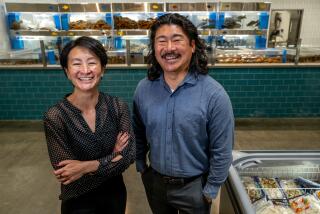Your L.A. farmers market-driven drought update
- Share via
The news came via Instagram, as much of the news does these days. “Dear Valued Customers,” the text read, “ Due to Stage III drought conditions I have been mandated to cut my water use by 42%.”
In black typeface against a white square background, Romeo Coleman who, along with his father Bill and mother Delia, runs Coleman Family Farms in Carpinteria and Oak View, spelled out an all-too-common scenario for Southern California farmers: As we adapt to the drought, consumers need to brace for higher prices and reduced harvests.
Four years in, the drought has become a new normal for many farmers, but August is when the dry season peaks in Southern California and farmers are feeling the heat. Across the jigsaw puzzle that is California water districts, water woes range from crippling allocations in Kern County to mandatory reductions across Ventura County.
Driving the 18 miles back and forth from his dad’s property in Carpinteria to his 12-acre plot in Oak View, Romeo Coleman has watched as islands emerge and boat docks descend with his primary water supply, Lake Casitas, a reservoir run by one of a handful of Southern California water districts that is entirely self sufficient. At Oak View he relies on water from the lake, so the 42% cutback is the sum of last year’s state-mandated reductions for urban users combined with local restrictions that took effect last month.
“It’s like someone wrapping their hands around my neck and slowly squeezing,” Coleman says of the cutbacks. “The hands are just getting tighter and tighter.”
Seasonal specialties like melons and cranberry beans have been completely taken off the farm’s roster, while lettuce and kale plantings have been severely reduced. For the restaurants that tout Coleman Family Farms lettuces on their menus, wholesale prices no longer apply.
Chef Evan Funke, whose restaurant Felix will open later this year in Venice, shook his head while Coleman broke the news at a recent Wednesday Santa Monica farmers market. While he’s not yet shopping for the restaurant, Funke is determined to support Coleman through the lean years. “That’s what being sustainable is,” Funke said, snacking on raw green beans. “You have to support the whole system.”
Two years ago, Funke, along with other chefs from around the city, hosted a fundraiser for farmer James Birch when two of the three riverbeds that feed his Flora Bella Farms in Three Rivers went dry. At the time, the drought had all but decimated Birch’s 40 acres on the edge of Sequoia National Park. Hungry deer and bears from the Sierra Nevadas ransacked his row crops and fruit trees, foraging for the food they were missing in the mountains.
As farmers do, Birch adapted, converting to drip irrigation, digging additional ponds to capture what water was left and building a deer fence to protect his harvest. After an impressive snowfall this year (87% of average compared to 5% in 2015), the Kaweah River is once again flowing, but Birch knows it’s a temporary fix. “If we don’t continue to get rain and snow in the Sierras, I’ll experience this again next year,” he says, so he’s cut his water use by 50% and remains focused on conservation.
Birch owns his water rights, which were secured by deed to his property when the land was first purchased in the late 1800s. In wet years, there’s little need to quibble with his seven neighbors over the water that flows to their properties by way of a three-mile ditch, but in dry years he and his cattle-ranching neighbor form an ad hoc water policing unit, ensuring that no one is exceeding their allocations. The community receives no state or federal water, which means that the reservoirs to the south provide zero security, no matter how dire their situation. During the drought, Birch says, “I’m the first to get the water and the first to run out.”
Travel an hour and a half south of Birch’s farm on State Route 65 and the land is more parched. In Bakersfield, a quarter of the community’s cherry orchards have been razed, replanted or reduced to stumps.
Two years ago farmer Steve Murray pulled out 25 acres of cherries, usually his bread and butter, and replanted with new varieties better suited for warmer winters. But this year’s heavy snowpack and rainfall in the north never reached the flatlands south of the Sierras. The rain that did fall in Bakersfield this year came unusually late, just seven days before the cherry harvest, ruining what the farmer thought would be a banner year.
“I thought the bank was going to require me to sell land this year,” Murray said. This is the second year in a row that the family has been struck with a 90% crop loss on cherries, but Murray remains hopeful for 2017. He doesn’t have another choice; last year he cashed in a 25-year pension to keep the farm afloat.
Unlike James Birch, Murray is supplied by the Arvin-Edison water district, which received none of its San Joaquin River allocation in 2014, and a mere 5% in 2015. This year’s Northern California storms recharged the river enough to merit a 60% allocation, which sounds flush in comparison, but is still 40% less than what farmers require to keep their acreage thriving. So far, Murray has been able to cobble together a piecemeal water supply by purchasing allocations from neighbors who sell unused water back to the district, but the resource comes at a premium. In the next two months he will spend an additional $36,000 on water to sustain his farm and keep his fruit trees alive.
Water, of course, is a necessity for farming, but it’s also essential for maintaining a healthy farm ecosystem. Phil McGrath, who farms off the 101 Freeway in Camarillo, is battling increasingly salty soil and more squirrels than he has seen in his entire farming career. “Everybody’s thirsty,” he says. “Everybody’s hungry.”
McGrath, who produced only half of his farm’s average yield this year, is quick to offer an earful on the issues affecting Southern California farmers – labor shortages, land-use legislation and, of course, water – but like Coleman, Birch and Murray, he remains hopeful.
“There is no one more optimistic than a farmer,” McGrath says, paraphrasing Will Rogers. “Anytime we plant a seed we hope for the best.
ALSO:
How to make ice cream and other frozen treats without a machine
What’s new in Michael McCarty’s garden of California cuisine: Miles Thompson takes over as chef
Jonathan Gold says Shibumi in DTLA feels like a Tokyo restaurant — and you should order cucumbers
More to Read
Eat your way across L.A.
Get our weekly Tasting Notes newsletter for reviews, news and more.
You may occasionally receive promotional content from the Los Angeles Times.






